Ten years have passed since WDJ explored “conservative management” – the nonsurgical treatment – of knee ligament injuries (see “Saying ‘No’ to Surgery,” February 2010). Since then, although surgery remains by far the most widely used knee injury treatment, consumer demand for complementary therapies, including the use of custom-designed knee braces, has grown.
Nearly all veterinarians have experience with canine ligament injuries because they are so common. Depending on the injury’s severity, a dog may have a hint of hind-leg lameness, an obvious limp, or be unable to bear weight on the leg at all. The injury may be a partial or total ligament tear.
“Most veterinarians recommend surgery as soon as they diagnose a ligament injury,” says Jim Alaimo, a board-certified Prosthetist Orthotist, “but that’s because surgery is their most familiar option.”
Alaimo, who founded My Pet’s Brace in 2010, made the transition to veterinary braces after designing human prosthetics and orthotics for 25 years. Prosthetics are artificial replacements for body parts such as arms, legs, and joints, while orthotics are devices such as splints or braces that support, immobilize, or treat weak or injured muscles, bones, or joints.
“Surgery is often the best treatment for canine cruciate ligament tears,” he explains, “but in some cases a dog’s age, medical history, activity level, home environment, or the cost of surgery makes it unsuitable. A well-designed custom-fitted knee brace can help a dog recover from a torn cranial cruciate ligament by supporting the joint while scar tissue builds stability.”
Knee braces can also be used for arthritis and post-surgical cruciate support. Like tendons, ligaments have a poor blood supply and, as a result, heal very slowly. According to Alaimo, it’s the development of scar tissue that stabilizes the knee and helps an injured leg move normally.
An online search will bring up dozens of knee brace designs, but most veterinarians familiar with bracing recommend custom-built braces that are made for a specific dog’s injured leg using modern technologies. The key to success is the brace’s ability to hold the leg in a correctly aligned stable position while allowing the dog to move naturally.
“Torn ACLs” and “bad knees” are familiar phrases in the world of dogs. Understanding what these terms mean can help if your dog suffers a knee injury that requires medical attention.
In this article the term “canine cruciate ligament disease” describes various injuries that can affect the dog’s knee. In generic use, the term accurately employs the word “disease,” because even though it’s often a traumatic injury that causes an acute tear or rupture of the ligaments in a dog’s knee, the majority of ligament ruptures occur under normal activity.
Also, according to an article published in the 2011 World Small Animal Veterinary Association World Congress Proceedings (“Review of Cranial Cruciate Ligament Disease in Dogs”), a number of studies suggest that the majority of knee ligament injuries are the result of chronic degenerative changes within the ligament.
DEFINITIONS OF RELEVANT TERMS
Ligaments are bands of fibrous tissue that connect bones and cartilage while supporting and strengthening joints.
The stifle (knee) connects the femur (thigh bone) and tibia (leg bone) with a patella (kneecap) in front and fabella (a small bean-shaped bone) behind. Cartilage (the medial meniscus and lateral meniscus) cushions the bones, and ligaments hold everything in position.
The cranial (front) and caudal (back) cruciate ligaments cross inside the knee joint. The cranial cruciate ligament prevents the tibia from slipping out of position beneath the femur. The term “anterior cruciate ligament” (ACL) is used in human medicine and “cranial cruciate ligament” (CCL) is a veterinary term, but both terms refer to the same ligament and both are used to describe knee injuries in dogs.
Radiographs (x-rays) are commonly used to check for cruciate ligament disease even though they do not display soft tissue and cannot be used to diagnose a cruciate injury or differentiate between a partial and complete tear. They can, however, rule out bone cancer or other conditions that may be a cause of leg pain. Advanced imaging studies, such as an MRI, do display torn ligaments but are expensive and require anesthesia, so they are not usually used in dogs.
The main diagnostic tool for CCL tears is a procedure called the “drawer test,” in which a veterinarian holds the femur with one hand and manipulates the tibia with the other. If the tibia can be moved forward, resembling a drawer being opened, the cruciate ligament has been torn or ruptured. The drawer test can be inconclusive if an apprehensive dog’s tense muscles stabilize the knee temporarily, so anxious patients may be sedated before being tested.
In the tibial compression test, which is another way to check for ligament damage, the femur is held steady with one hand while the other hand flexes the dog’s ankle. A ruptured ligament allows the tibia to move abnormally forward.
A recent estimate quoted by several veterinary websites is that more than 600,000 dogs in the United States have cruciate ligament surgery every year.
According to the American College of Veterinary Surgeons (acvs.org) canine cruciate ligament disease risk factors include aging of the ligament (degeneration), obesity, poor physical condition, genetics, conformation (skeletal shape and configuration), and breed. Most ligaments rupture as a result of subtle, slow degeneration that has taken place over months or even years rather than because of an acute trauma to an otherwise healthy ligament. An estimated 40% to 60% of dogs with cruciate ligament damage in one knee eventually injure the other knee. The ACVS advises that, left untreated, partial tearing of the cruciate ligament is likely to progress to a full tear over time.
The ACVS states that CCL injuries can affect dogs of all sizes, breeds, and ages, with the Rottweiler, Newfoundland, Staffordshire Terrier, Mastiff, Akita, Saint Bernard, Chesapeake Bay Retriever, and Labrador Retriever commonly affected.
Neutering before the age of 1 year has been statistically linked to torn cruciate ligaments. On July 7, 2020, the journal Frontiers of Veterinary Science published “Assisting Decision-Making on Age of Neutering for 35 Breeds of Dogs: Associated Joint Disorders, Cancers, and Urinary Incontinence” (Benjamin Hart, et al,) that showed significant increases in cruciate ligament risk related to the early neutering of male Bernese Mountain Dogs, Cocker Spaniels, and Miniature Poodles; male and female German Shepherd Dogs, Golden Retrievers, Labrador Retrievers, and Rottweilers; and female Saint Bernards and Australian Cattle Dogs.
The study concluded, “A likely mechanism by which early neutering may lead to a joint disorder is related to disturbance of the closure of the long-bone growth plates by gonadal hormone secretion as the animal approaches maturity. We have proposed that neutering much before the closure of growth plates allows the long bones to grow a little longer than normal, and may sufficiently disturb joint alignments in some neutered dogs to lead to a clinically apparent joint disorder.”
A related study, “Assisting Decision-Making on Age of Neutering for Mixed Breed Dogs of Five Weight Categories: Associated Joint Disorders and Cancers” (Frontiers of Veterinary Science, July 31, 2020, Benjamin Hart, et al), showed similar results in mixed breeds, especially for dogs weighing 44 pounds or more and neutered before one year of age.
Owners can’t change the status of dogs who are already neutered, but there is much we can do to protect the knees of our at-risk companions. As the ACVS website explains, “Poor physical body condition and excessive body weight are risk factors for the development of canine cruciate ligament disease. Both of these factors can be influenced by pet owners. Consistent physical conditioning with regular activity and close monitoring of food intake to maintain a lean body mass is advisable.”
HOW KNEE BRACES ARE MADE
Different manufacturers use different materials and methods to create custom braces, which may be called knee, stifle, ACL, or CCL braces. Braces are also designed for canine wrists, ankles, hocks, and hips.
The first step in custom brace design is a review of the patient’s size, breed, medical history, activity level, and environment to determine how strong the brace has to be to support the dog’s weight and activities as well as what special features the brace may require.
Next, casts or detailed measurements create a model of the dog’s knee. Jim Alaimo at My Pet’s Brace uses fiberglass to create a cast of the dog’s affected leg.
Alaimo describes, “We fill the cast with plaster, and that gives us a positive model of the leg. Then we remove plaster from some areas and add it to others in order to increase or relieve pressure as needed. We add knee joints, foam, and any needed reinforcements. Then we take polypropoline (a thermoplastic polymer), heat it, and vacuum-form it over the modified model of the dog’s leg. After it hardens, we cut it off, take it to the machine room, smooth out the edges, add joints and straps, and we have a finished brace. We use closed-cell foam and stainless-steel fasteners to make the brace fully waterproof.”
The final step is a fitting appointment during which any necessary adjustments are made along with videos and photos of the dog walking and moving in the brace. “During the eight or nine months that the dog wears a brace,” says Alaimo, “we schedule follow-up appointments to measure progress.”
After a break-in period, the dog wears his or her brace during waking hours. “Most dogs put it on in the morning and take it off in the evening before bed,” he says.
Penny, a lively 83-pound Newfoundland living with Regina Helfer in Maine, injured her right hind leg in September 2019, shortly before her ninth birthday. “She tore her ACL,” says Helfer, “and the vet on duty recommended immediate surgery.” Instead, Helfer asked Penny’s breeder (as well as the breeder of her other dog) for advice. Both breeders recommended My Pet’s Brace.
“We received the brace in September,” says Helfer, “and Penny did really well with it. She didn’t have any challenges at all. Penny is a therapy dog and a Reading Education Assistance Dog. She loves going to the library, working with kids, going for walks, and going for swims. We got her a hot pink brace and whenever we put it on her, she would stick her leg out to help.
“Penny wore her brace every day for nine months, by which time she had fully recovered. It’s here in case she needs it, such as if she goes on a long or challenging hike just to keep the leg stabilized, but so far she’s doing fine without it.”
HERO BRACES
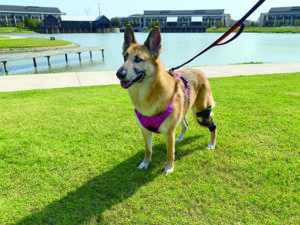
Ben Blecha has a personal as well as professional interest in leg braces. An osteosarcoma survivor whose leg amputation at age 21 inspired him to help others, Blecha became a board-certified Prosthetist Orthotist. Until 2005, when he was asked to help create a brace for a dog, all of his patients were human. He went on to partner with Wayne Watkins, DVM, to create Hero Braces for dogs.
Last year, June, a 5-year-old 100-pound German Shepherd Dog belonging to Ben Elsen of Dallas, Texas, began favoring her left hind leg. “June lives with her sister and littermate, Shiner,” says Elsen, “and they have always played hard every day. Starting two years ago, my wife and I were warned that June’s knee was beginning to show signs of wear and tear.”
Despite a reduced exercise schedule, June stopped jumping onto the bed and sofa. In October 2019, she was diagnosed with arthritis and a torn knee ligament. “Our veterinarian recommended immediate surgery,” says Elsen, “but we had misgivings, both about the cost and because June and her sister are always together, so weeks of rehabilitation would be stressful for both of them. When we asked about braces, our vet said he didn’t recommend them. But when he referred us to a surgical center, we met a rehabilitation specialist who thought highly of braces and recommended the Hero Brace.”
The specialist made a cast of June’s leg and 10 days later she was fitted with her brace. “She was fine with it from the start,” says Elsen. “We kept it on her at home and on walks, and her knee responded just as expected. We still use it while hiking, but otherwise, June is doing well without it. She’s back to jumping onto the bed and sofa, and she doesn’t favor her left side at all.”
TO CAST OR NOT TO CAST
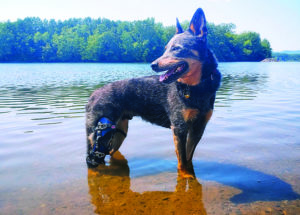
Most custom braces are designed around models of legs that were cast in a veterinary clinic or at the client’s home with materials provided by the brace manufacturer. The resulting cast is submitted with supporting measurements so that the brace can be designed to fit. In some cases casting has to be repeated because of damage to the cast during shipment or because the cast was incorrectly made. If done in a veterinary clinic, the appointment adds to the brace’s cost.
The Posh Dog Knee Brace was developed seven years ago after Pasha, an 11-year-old, 77-pound Golden Retriever, injured her left hind leg. Pasha’s veterinarian diagnosed a ruptured cranial cruciate ligament and torn meniscus for which he recommended immediate surgery, warning that if left untreated, the strain would cause a similar injury to the right leg, result in severe arthritis, and prevent Pasha from ever living an active life.
Pasha’s owners, Florida residents Jim Morison and Beth Scanlon, could afford the $5,000 surgery, but they worried about Pasha’s age and medical history, which included an adverse reaction to anesthesia. Instead of scheduling surgery, they ordered a custom-made knee brace, and Pasha’s recovery began.
While delighted with Pasha’s progress, Morison thought that several features of the brace could be improved. He began designing adjustments and in the process launched his own knee brace company, which he named Posh, one of Pasha’s nicknames. Within six months of wearing her improved brace, Pasha was running through tide pools and swimming at the beach, and within nine months she had completely recovered.
“Posh started with the type of brace that requires a casting mold, but we now use a different design,” says Nikki Bickmore, who as lead veterinary technician at Posh, answers questions from clients, supervises the service department, and oversees production.
“In order to eliminate casting, Posh hired a team of orthotists and veterinarians to design a new system,” Bickmore explains. “The result is a semi-rigid brace instead of hard plastic, with multiple padding layers, so the brace works with the dog’s muscles as they move and contract. Ours is the only brace that uses Tamarack brand double-reinforced hinges mounted on two layers of plastic to improve the brace’s strength at critical stress points. The brace fits without any rubbing, irritation, or slipping and attaches with quick-release micro buckles found in high-end snow sports and water sports equipment.”
Using measurements instead of casting to provide a model of the dog’s leg both speeds up and slows down the ordering process. Once accurate measurements are provided, most braces arrive within a week, but because clients must study video instructions and take measurements with two people under the supervision of a veterinary technician during a live video conference, ordering takes longer. Before a Posh brace can be worn, it must be fitted in another video conference, again under the supervision of a Posh vet tech.
“What people most like about our braces,” says Bickman, “is that they are easy to use and fit well. They like our system of straps and buckles so there’s no need for Velcro, which can get tangled in a dog’s hair. The brace is comfortable because we use a soft rather than hard shell, and it allows for more freedom of movement, plus it’s durable and super easy to clean.”
Howdy, a 3-year-old Australian Cattle dog, was born with spina bifida and nerve damage in his hind end, as well as incontinence. “He’s a favorite of the Posh staff,” says Bickman. “Alicia McLaughlin adopted him at 6 months, and soon after that he injured his CCL, plus he had a luxating patella concurrent with the CCL tear. Many people thought he should be euthanized, but with bracing, and lots of love and patience, he now lives a happy country life in New York with Alicia.”
KNEE BRACES AND REHAB
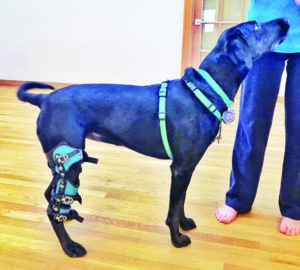
All of the manufacturers mentioned here provide detailed instructions for owners and caregivers regarding exercise, recommended activities, do’s and don’ts, and other guidelines.
“The success of a dog’s recovery depends on an educated owner,” says Jim Alaimo. “Owners have to be good observers and also use the brace consistently. Our goal is to provide a conservative treatment modality for owners so their dogs can resume a full, active lifestyle as quickly and comfortably as possible.”
Paul Brumett, DVM, is a Colorado veterinarian and Certified Canine Rehabilitation Practitioner. Since 2018, as a representative and consultant for Hero Braces, he has presented educational seminars about braces to veterinarians. “Over the past 10 years,” he explains, “veterinarians have become more interested in learning about braces, partly because so many of their clients ask about them. Braces are not a cure-all, but not every dog is a good candidate for surgery, and I help veterinarians like myself understand the proper use and benefits of custom bracing.”
Dr. Brumett estimates that 25% of his dog patients suffer from cruciate ligament disease, and for 5% to 10% of them he prescribes a custom made knee brace.
“During the healing process,” he says, “dogs are helped by complementary therapies such as acupuncture, laser therapy, nutritional support, chiropractic adjustments, pulsed electromagnetic field (PEMF) therapy, massage, stretching, and rehabilitation exercises that improve core strength and balance. The braces are waterproof, allowing dogs to exercise on underwater treadmills or swim while wearing their brace, and they can walk in the rain and enjoy snow as well.”
Dr. Brumett recommends a gradual break-in period that introduces the dog to his or her custom brace over a week to 10 days. Leash walks are kept short, such as 15 to 20 minutes in the beginning, and the pet wears the brace for longer periods each day.
“Many dogs need time for the muscles around the knee to get strong enough to support longer walks,” he says, “which is why it’s important to work with the prescribing veterinarian or physical therapist. Wearing the brace protects the knee from abnormal movement such as when the dog stands suddenly because the doorbell rings. We want the custom brace to be in place so it can do its job. Gradually, pets work up to eight to 12 hours of wear each day.”
“The main challenge owners have is actually using the product consistently and planning appropriate activities for their dogs,” says Nikki Bickmore. “It breaks my heart when someone forgets and lets a dog who’s been using a brace for two months run outside without the brace. That can result in a major setback. I know it’s hard, but keeping dogs in a conservative management program while their knees strengthen and the muscles come back is so important.”
MORE BRACING CONSIDERATIONS
If your dog begins to favor a hind leg, don’t assume the problem will go away on its own. It might, but it could be a symptom of cruciate ligament disease. Schedule an appointment with your veterinarian to be sure.
Surgery requires careful consideration, but so does the use of a brace. The custom-fitted braces described here are not inexpensive, and their successful use depends on commitments of time and attention. Not every dog is a good match to bracing and neither is every owner. The key to making informed decisions is gathering information and having a realistic understanding of what’s involved.
To explore custom knee braces, visit the websites of companies listed here. Consider how the brace is manufactured, who makes it and what their qualifications are, what warranties the company provides, how customer support works, the cost of replacement braces, the company’s experience with dogs like yours, and brace color or decorative design choices.
Where available, read customer comments and watch videos that demonstrate brace fitting and use. Custom braces are made to last a lifetime. Some companies offer discounts if two braces are needed (one for each hind leg) or to convert a brace for use on the opposite leg at a later date.
Several of the manufacturers listed in the table on page 17 create braces or prosthetics for animals other than dogs as well as braces for other body parts. This list refers only to custom-made canine knee braces. For best results, consult with your veterinarian, Certified Canine Rehabilitation Specialist, or other expert for advice and recommendations.
Montana resident CJ Puotinen is a long-time contributor to WDJ and the author of The Encyclopedia of Natural Pet Care and other books.


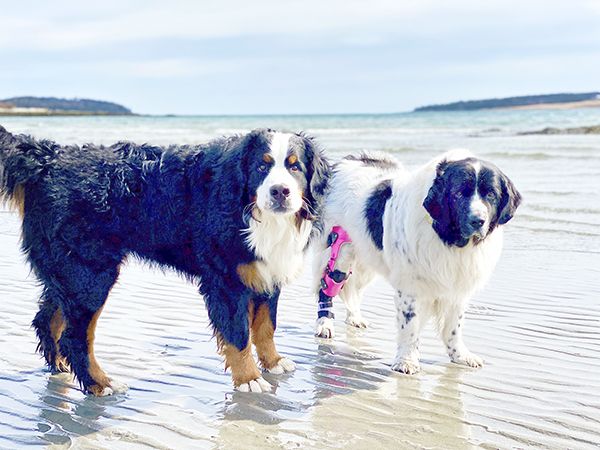
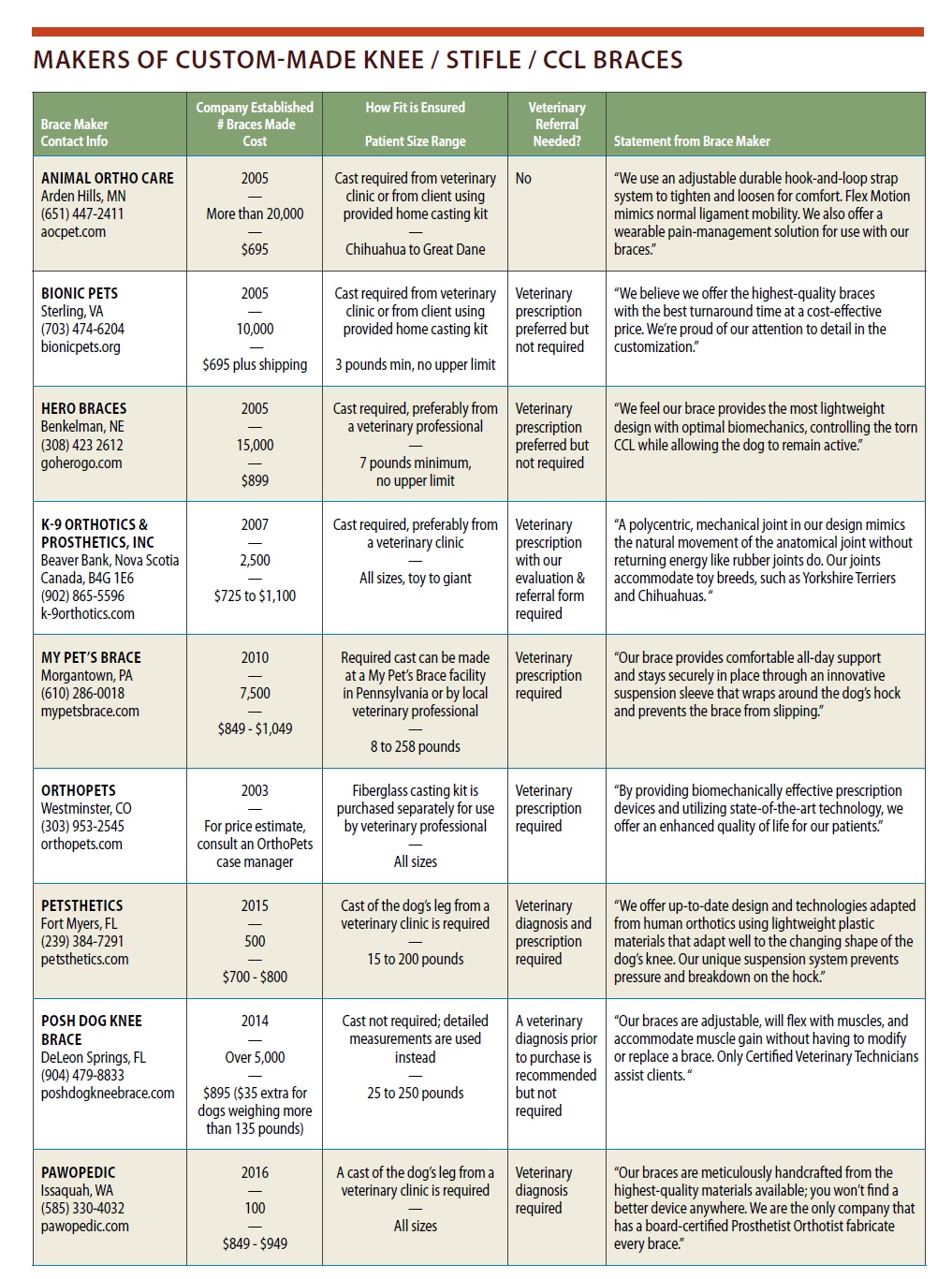




I have learned a lot! Thanks for the information!
I got a brace from Animal Ortho for my dog. It worked miracles and I’d recommend looking into a custom brace before opting for invasive surgery. At Animal Ortho, Derrick Compana has done braces and prosthetics for many animals including horses and elephants! His brace really helped my dog with an ACL injury.
This is a bery good article thank keep doing what you doing .
8 year old female golden retriever had a ACL (spell checker ) right hind leg. Animal ortho care gave me instructions how to measure . Received with instructions how to make fit. She didn’t try to remove it and within minutes of it on she was putting some weight on leg. After a short period of time she was walking with a small shortened stride. After a couple of months she was even lightly running. Was fantastic ! So recommend this on an older dog .she was even swimming with this on .
Thank you for all this wonderful information.
I’ve found that if you don’t put a brace in both legs then the unijured leg will also become injured. This should be told to all people who are interested in this therepy. The leg not injured will get overused and cause a new problem 9 weeks later.
The same is true with people. My sister in law injured her knee and eventually the other knee was compromised as well. But I don’t know how well she followed doctor’s orders after the first knee injury. I suspect she didn’t use crutches or a brace as she was supposed to do.
My parent’s previous dog injured her hind leg at about age 12. Because of her age and weight we opted for a brace. The veterinarian was pushing surgery but also said that the chances of her healing and recovery weren’t that good. I did some research online and I believe we opted for the HERO brace. She was measured at a clinic. It took a bit longer for it to arrive and my parents never did take her to the final fitting. I would put it on her when I arrived to visit and take it off when I left but I don’t know how often they did it. She wasn’t that mobile anyway, spending a lot of time sleeping. But they did take daily walks and I noticed she was more mobile when she was wearing the brace. If it happened to my dog under the same circumstances I would opt for a brace rather than surgery. I think surgery is fine for a younger dog but I feel the risks once a dog is over 10 years old outweigh the benefits.
At the time there were only about three or four companies doing orthopedic braces for dog’s ACL injuries. I’m glad to see there are many more that offer more choices. My Diana pawPrints is an active 100 lb two year old. If she injured herself today I would probably opt for surgery. But if she does it at 9 or 10 years old, I would opt for a brace.
Debated on a hard brace for a long time. I did get a custom fit soft brace from Mutt Knee Brace in CO. Fortunately Jasper is small 20 pounds and very fit. The brace coupled with building walks massage herbal supplements helped. The biggest improvement was starting Wobenzyme N. Supplementing 3 times a day and now twice a day he is not favoring the leg and walking about 15 miles a week. He is off leash with the other dogs on walks and is great. I will always keep him on the wobenzym.
Please dont forget stem cell therapy for ccl tears. My 4 yr old boy was diagnosed with a partial tear in January 2020. The orthopedic surgeon immediately recommended TPLO surgery. I researched conservative treatments, including braces, and almost settled on the Posh knee brace before I came across studies on stem cell therapy. February 2020 he had Vet Stem cell therapy procedure done where his own stem cells were harvested through surgical removal of abdominal fat pads. 8 weeks later he was perfect! Running and playing like nothing ever happened! I am so glad I opted for a less aggressive treatment!
I am having my 4 year old Golden Retriever injected with stem cells as soon as possible for a meniscus tear.
Did you use any brace before or after the stem cell therapy?
It makes sense to my husband and I we should keep the knee stable while it heals. Both of us have had stem cell therapy and agree it is almost miraculous!
My 65 lb. lab mix suffered an injury to her left hind leg a couple of years ago while chasing balls that I was throwing for her to fetch. The vet was sure it was an ACL issue and gave her pain meds to make her comfortable for a few days because she was unable to put any weight on the back leg. The vet said she would reassess her and give me a referral for the surgery at the next appointment. I was determined to nurse her back to good and stable health without surgery. I slept on a blow up mattress on the first floor to keep her away from steps and jumping on or off the bed for 3 weeks., (the other two dogs kept us company, too). She was on limited movement with just leash walk to potty for those 3 weeks. I researched and found a site that recommended ORTO CANIS, (a company in Spain), soft braces that fit over the leg and strap around her waist. I read all the reviews and found an interesting point made by so many of the european dog owners commented that they are not quick to go the surgery route for these injuries but, instead, rely on limited movement and slow, watchful recovery with the use of the braces. I ordered online and used their guide for measuring her. I was thrilled at the ease with which I was able to fit her with the brace and it gave her the stability she needed to walk. She wore the brace as we increased her distance on the walks and soon did not need to wear the brace after about four months out from the injury. I highly recommend anyone who would like to avoid the surgery, depending on the severity of the injury, and look into Ortocanis.com. I was very pleased with my dog’s recovery using their brace.
I must add, that I enrolled Dakota in Hydro Therapy, which was an amazing adjunct to her daily massages by me.. I bought a pack of ten and used five. I have a credit of five, just in case. She did hydro therapy once a week for five weeks. Hydro Therapy is an amazing therapy that we are fortunate to have available for our dogs recovery!
When our 10 year old English Cocker tore his left cruciate we opted for surgery and follow-up PT for 3 months and he recovered well. 3 years later, at 13 years of age he tore the right cruciate and we were faced with a different decision. Coal has liver disease and is an older guy. Despite the fact that he is in excellent shape otherwise, we were unsure about the surgical procedure, anesthesia and long recovery. After a great deal of research and consideration we ended up with a brace from My Pet’s Brace. Other than the long drive to Morgantown, PA for molding, fitting, follow-up… the experience was fantastic. He wore the brace for 9 months and still wears it when he does more strenuous activity or in icy conditions, but today that now 14 year old dog climbed the mountain in Telluride and still had energy to celebrate back at home! Thank you My Pet’s Brace for a wonderful experience with a very difficult injury! Great article.
Omg just found out couple weeks ago that my lil angel 👼 has arthritis setting in her back legs and also that her right back knee is lifting and dislocating at times especially in rain 🌧 I’ve been down since hearing the thing I seen after news of course. Forced to face the reality that she’s 11 yrs old so I most definitely want her to be as comfortable as possible no matter the cost .
First thing I saw when opening my email was your knee brace for dogs!!! I’d say that’s meant to be….. I definitely NEED and WANT a FEW for my poor lil GIRL I’M excited to get the process
Omg just found out couple weeks ago that my lil angel 👼 has arthritis setting in her back legs and also that her right back knee is lifting and dislocating at times especially in rain 🌧 I’ve been down since hearing the thing I seen after news of course. Forced to face the reality that she’s 11 yrs old so I most definitely want her to be as comfortable as possible no matter the cost .
First thing I saw when opening my email was your knee brace for dogs!!! I’d say that’s meant to be….. I definitely NEED and WANT a FEW for my poor lil GIRL I’M excited to get the process started
My dog just sustained an cruciate ligament injury and I had questions so I went to my Whole Dog Journal team for information. This article has helped immensely in deciding how to move forward with his care. Thank you for always being a reliable source of info when I’m in need!
I used Posh Dog Knee Brace to help my dog with his torn ACL/CCL anyone looking for a dog knee brace or elbow brace should check them out. https://poshdogkneebrace.com/